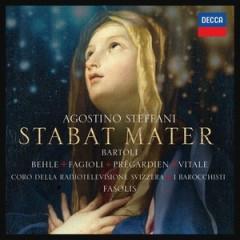Agostino Steffani - Stabat Mater (2013)
Agostino Steffani - Stabat Mater (2013)

Stabat Mater 01. I. Stabat Mater dolorosa 02. II. Cujus animan gementem 03. III. Quis est homo qui non fleret 04. IV. Pro peccatis suae gentis 05. V. Vidit suum dulcem Natum 06. VI. Eja Mater, fons amoris 07. VII. Fac me vere tecum flere 08. VIII. Virgo virginum preclara 09. IX. Fac, ut portem Christi mortem 10. X. Fac me plagis vulnerari 11. XI. Inflammatus et accensus 12. XII. Quando corpus morietur 13. Beatus vir 14. Non plus me ligate 15. Triduanas a Domino 16. Laudate pueri 17. Sperate in Deo 18. Qui diligit Mariam Cecilia Bartoli - soprano Nuria Rial - soprano Yetzabel Arias Fernandez - soprano Elena Carzaniga - mezzo-soprano Franco Fagioli - countertenor Daniel Behle - tenor Julian Pregardien - tenor Salvo Vitale - bass Coro della Radiotelevisione svizzera, Lugano I Barocchisti Diego Fasolis – conductor
Agostino Steffani, roughly contemporary with Arcangelo Corelli, worked mostly in Germany and was known across the continent for his operatic music. Some of it was championed by mezzo soprano Cecilia Bartoli on her daring Mission album. Now Bartoli, properly more in the background as part of a sacred-music ensemble, returns with an album of Steffani's religious music, for which he was equally renowned. She joins a group of fine soloists, many of whom will be familiar to early music devotees and quite worthy of the broader audience association with Bartoli and the major Decca label will bring. The vigorous instrumental ensemble I Barocchisti, its leader Diego Fasolis, and the commendably sizable Swiss Radio Choir are all top-notch. As for the music itself, the six sacred pieces (psalms, antiphons, motets) that conclude the album give the best idea of the diversity of Steffani's style. Some are partly in the pure Palestrina traditional unaccompanied choral style; some are in the Italian style of the middle 17th century with grand oppositions of choral groups; and some reflect up-to-the-minute solo vocal writing. Bartoli fans will naturally gravitate toward an example of the latter, Non plus me ligate (track 9), and it's gorgeous. But Bartoli, whose voice has taken on some fascinating burnished tones that she is allowed to let speak for themselves here, is also featured prominently in the main attraction, the Stabat Mater, which stands somewhat apart from the rest of the music and fell into disuse soon after Steffani's death, probably because it was already somewhat old-fashioned. But it is old-fashioned in the way that Bach's music is old-fashioned. Like Pergolesi's setting of this somber text, it was the composer's swan song, written at the end of his long life, and it is a tragic work indeed. It might be beautifully paired in performance with the Pergolesi work. Bartoli and her gorgeous lower register have plenty to do, but the spotlight at the end falls on the male soloists, Daniel Behle, Julian Prégardien, and Salvo Vitale, whose trio work is positively sepulchral. This is a gorgeous performance of a work unjustly neglected by music history. Highly recommended. ---James Manheim, AllMusic Review
download (mp3 @320 kbs):
yandex 4shared mega mediafire uloz.to cloudmailru uptobox ge.tt








